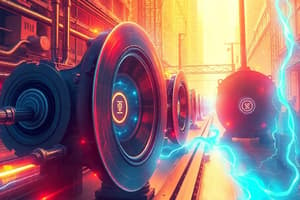Podcast
Questions and Answers
What is the main difference between a squirrel cage induction motor and a wound rotor induction motor?
What is the main difference between a squirrel cage induction motor and a wound rotor induction motor?
Rotor structure and starting torque
What is the principle of operation of induction machines?
What is the principle of operation of induction machines?
Electromagnetic induction
What is the purpose of voltage control in induction motors?
What is the purpose of voltage control in induction motors?
To control the speed
What is the formula to calculate the torque of an induction motor?
What is the formula to calculate the torque of an induction motor?
What are some common applications of induction motors in industrial settings?
What are some common applications of induction motors in industrial settings?
What is the characteristic of the torque-speed curve of an induction motor?
What is the characteristic of the torque-speed curve of an induction motor?
What is the advantage of using a reluctance motor?
What is the advantage of using a reluctance motor?
Flashcards are hidden until you start studying
Study Notes
Principle of Operation
- Induction machines work on the principle of electromagnetic induction
- A 3-phase AC current is supplied to the stator windings, creating a rotating magnetic field
- The rotating magnetic field induces an electromotive force (EMF) in the rotor conductors
- The induced EMF causes a current to flow in the rotor, producing a torque that rotates the rotor
Types of Induction Motors
- Squirrel Cage Induction Motor: has a rotor with a squirrel cage structure, widely used in industrial applications
- Wound Rotor Induction Motor: has a rotor with a wound coil, used in applications requiring high starting torque
- Slip Ring Induction Motor: has a rotor with a slip ring, used in applications requiring high starting torque and speed control
- Reluctance Motor: has a rotor with a reluctance structure, used in applications requiring high efficiency and low maintenance
Speed Control
- Voltage Control: controlling the voltage supplied to the stator windings to control the speed
- Frequency Control: controlling the frequency of the supplied voltage to control the speed
- Pole Changing: changing the number of poles in the stator windings to control the speed
- Cascade Control: using multiple induction motors in a cascade configuration to control the speed
Applications
- Industrial Applications: pumps, compressors, conveyor belts, and other industrial machinery
- HVAC Systems: heating, ventilation, and air conditioning systems
- Refrigeration Systems: refrigeration compressors and pumps
- Agricultural Applications: irrigation pumps, ventilation systems, and other agricultural machinery
Torque Calculation
- Torque Equation: T = (3 * I^2 * R) / (2 * π * n)
- Where T is the torque, I is the current, R is the resistance, and n is the speed
- Torque-Speed Characteristics: the relationship between torque and speed, which is typically linear
Self-Starting
- Self-Starting: the ability of an induction motor to start without an external starting device
- Cage Rotor: a squirrel cage rotor is self-starting due to the electromagnetic induction principle
- Wound Rotor: a wound rotor is not self-starting and requires an external starting device
- Starting Torque: the torque required to start the motor, which is typically higher than the running torque
Principle of Operation
- Induction machines work on the principle of electromagnetic induction, where a 3-phase AC current is supplied to the stator windings, creating a rotating magnetic field.
- The rotating magnetic field induces an electromotive force (EMF) in the rotor conductors.
- The induced EMF causes a current to flow in the rotor, producing a torque that rotates the rotor.
Types of Induction Motors
- Squirrel Cage Induction Motor has a rotor with a squirrel cage structure, widely used in industrial applications due to its simplicity and low maintenance.
- Wound Rotor Induction Motor has a rotor with a wound coil, used in applications requiring high starting torque.
- Slip Ring Induction Motor has a rotor with a slip ring, used in applications requiring high starting torque and speed control.
- Reluctance Motor has a rotor with a reluctance structure, used in applications requiring high efficiency and low maintenance.
Speed Control
- Voltage Control is a method of controlling the speed by varying the voltage supplied to the stator windings.
- Frequency Control is a method of controlling the speed by varying the frequency of the supplied voltage.
- Pole Changing is a method of controlling the speed by changing the number of poles in the stator windings.
- Cascade Control is a method of controlling the speed using multiple induction motors in a cascade configuration.
Applications
- Industrial Applications: pumps, compressors, conveyor belts, and other industrial machinery.
- HVAC Systems: heating, ventilation, and air conditioning systems.
- Refrigeration Systems: refrigeration compressors and pumps.
- Agricultural Applications: irrigation pumps, ventilation systems, and other agricultural machinery.
Torque Calculation
- The torque equation is T = (3 * I^2 * R) / (2 * π * n), where T is the torque, I is the current, R is the resistance, and n is the speed.
- The torque-speed characteristics of an induction motor are typically linear.
Self-Starting
- Self-Starting is the ability of an induction motor to start without an external starting device.
- Cage Rotor is self-starting due to the electromagnetic induction principle.
- Wound Rotor is not self-starting and requires an external starting device.
- Starting Torque is the torque required to start the motor, which is typically higher than the running torque.
Studying That Suits You
Use AI to generate personalized quizzes and flashcards to suit your learning preferences.




